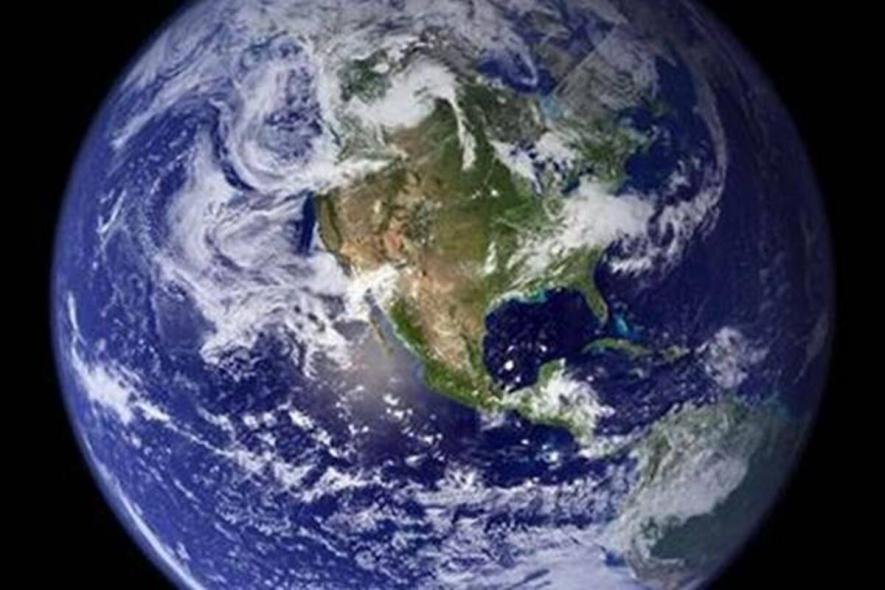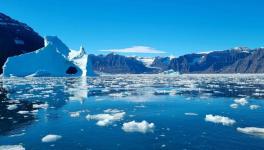Earth Day: Humans and Not Capitalism for our Survival

Image Courtesy: The Financial Express
'International Earth Day' celebrated each year on April 22, marked its 51st edition this year. It aims to protect ‘planet Earth from the grotesque challenges it faces; challenges for the survival of the planet and also of its living species, including human beings. A number of events were organised over the world by different communities and national leaders in this regard.
April 22 also marks the birth anniversary of V.I. Lenin, a philosopher and a communist who not only led the Russian revolution, but also clinched the binary between ‘subjective’ and ‘objective’ in his seminal work—'Materialism and Empirio-Criticism'. Defining objective to be anything beyond the human mind and not just related to matter in the physical form, he argued that human perception correctly and accurately reflect an objective external world.
If 'man' is subjective, the earth is part of an objective world. It is the dialectical relationship between the two that has – with centuries of the evolutionary process and the active role of ma – posed a serious threat to the earth and its living beings. The discourse, which would make us believe that it is ‘man’ as a universal being who is responsible for the degradation of nature, does not speak in socio-economic terms. But this is not true.
What does this mean? The earth as a planet is about 4.5 billion years old. The earliest life forms from the time when inanimate matter changed to animate is about 3.7 billion years old with evolutionary processes of succession on land and in water. The evolution of Homo Sapiens happened between 200,000 and 300,000 years ago. Man as a subjective conscious being with the ability to create new nature is just a fraction of the earth's period of existence.
The biggest challenge before us which is being debated across the world, is global warming leading to climate change due to an increase in carbon footprint and the emission of greenhouse gases (GHGs). GHG emissions have seen a dramatic rise in the last two centuries.
Human emissions of Carbon dioxide and other GHGs are a primary driver of climate change, and present one of the world’s most pressing challenges. GHG emissions from human activities are the main driver for the rise in temperature of almost 1.1 degrees Celsius from the pre-industrial era. Almost all the global warming since 1850 can be attributed to human emissions!
According to a IPCC(Intergovernmental Panel on Climate Change) report from 2014: “Anthropogenic greenhouse gas emissions have increased since the pre-industrial era, driven largely by economic and population growth, and are now higher than ever. This has led to atmospheric concentrations of carbon dioxide, methane and nitrous oxide that are unprecedented in at least the last 800,000 years. Their effects, together with those of other anthropogenic drivers, have been detected throughout the climate system and are extremely likely to have been the dominant cause of the observed warming since the mid-20th century.”
It is not as linear as it appears. It is the socio-economic system during this period that is responsible for the rise in carbon emissions. Capitalism, that sustains on the maximisation of profits and surplus production in the system, drives this blind race for productivity which is not for the society or the people, but for the accumulation of profits in its guise. This history of world capitalism is a classic example of how Earth has been denuded and the present challenges of carbon emissions pose the threat of a rise in global temperatures. Between the years 1758 and 2020, CO2 emissions swelled from 0.01 billion metric tons to 34.07 billion metric tons.
In simpler terms, it means that a degree rise in temperature will not just severely affect biodiversity, but will also spell doom for island nations and habitations at sea level. A crisis of this sort is already faced across the globe. 'The Anatomy of a Silent Crisis' is a comprehensive report prepared by the Global Humanitarian Forum. It deals with the challenges that the Earth and humankind face in the contemporary times of climate change.
The findings of the report indicate that each year climate change leaves over 3,00,000 people dead, 325 million people seriously affected, and causes economic losses worth US$125 billion. Four billion people are vulnerable, and 500 million people are at extreme risk. These already alarming figures may prove too conservative. Weather-related disasters alone cause significant economic losses. Over the past few years, this toll has gone as high as $230 billion. Such disasters have increased in frequency and severity over the past 30 years. We had seldom experienced snow in Himachal Pradesh in the month of April. However, just a few days ago on April 22, there was massive snowfall around Shimla, severely affecting the agriculture and horticulture prospects of the region. Likewise, there are extreme events experienced at a far rapid incidence; Kerala's flash floods are a recent example too.
The report also summarises the impact of climate change on different parts of the world and how it is linked to the whole issue of global justice. Developing countries bear over nine-tenths of the climate change burden: 98% of the seriously affected and 99% of all deaths from weather-related disasters, along with over 90% of the total economic losses. The 50 Least Developed Countries contribute less than one per cent of the total global carbon emissions. Climate change exacerbates existing inequalities faced by vulnerable groups, particularly women, children, and the elderly. The consequences of climate change and poverty are not distributed uniformly within communities. Individual and social factors determine vulnerability and the capacity to adapt to the effects of climate change. Women account for two-thirds of the world’s poor, and comprise about seven in ten agricultural workers. Women and children are disproportionately represented among people displaced by extreme weather events and other climate shocks. The poorest are hardest hit, but the human impact of climate change is a global issue.
The developed/capitalist countries cannot negate their historical responsibility and continue with their pillage of global climate at the expense of the vast majority of humanity. They need to be forced to continue to accept per capita emissions as the basis of energy equality as every human being on the planet should have equal access to carbon space. Such inequality – per capita emissions in the USA are over twelve times greater than per capita emissions in India – cannot be allowed to persist. But there the dilemma that those who are responsible for the havoc have little role to play in it; at the same time they cannot evade the responsibility.
Thus arose the concept of “common but differential responsibility”, in the Kyoto Protocol signed in 1997, which is an extension of the United Nations Framework Convention on Climate Change(UNFCCC). Article 4 para 7 of the UNFCC says, “commitments under the convention will depend on the effective implementation by developed country parties of their commitments under the Convention relating to financial resources and transfer of technology and will take fully into account that economic and social development and poverty eradication are the first and overriding priorities of the developing country parties.”
However, since the protocol was established, the developed capitalist world has not reduced its emissions and continues to harp on the dangerous path. Since COP 21 at France, $100 billion were to be transferred to the developing world, however, not even 50% of it has been achieved.
We then saw the Trump era, a US President who said that he would not abide by the COP 21 decisions and cannot agree to the commitments made.
SOME CHANGES WITNESSED
But we have seen how Trump, who advocated a ‘no deal’, was defeated in the US elections and that Joe Biden campaigned with the agenda of a Green New Deal, because of pressures from a large number of people who demanded that political leadership confronted climate reality. Millions marched on the streets before the pandemic to demand climate action. Coalitions like NY Renews in New York, Glf South for a Green New Deal and the Green New Deal Network are building a united front around a vision for a Green New Deal that could leverage significant political power. Stephen Maher, Sam Gindin and Leo Panitch write in the Socialist Register, 2020: “In the UK, Corbyn and Mc Donnel have advanced plans for a ‘green industrial revolution’ as a component of an industrial strategy that includes a new role of the Bank of England in supervising private investment.” However, we know the results and are aware that these pressures were not meaningful enough towards replacing the power of capitalist finance over investment with democratic planning in solidarity, capable of overcoming competitive pressures for profit-driven production.
There is a shift in the UN observance of the day as well – a shift from mitigating and adapting strategies to more individual-oriented tasks. This aspect does not hit at the core issue and systemic changes in the world social system. Except for some of the debates within the capitalist world led by the socialists who are seeking democratic control over the production process and also pushing for the green deal, changing the system for the better is still not on the agenda.
Let us take just one example, and that is the way how the cities are built in the world. Why cities? Because, as of today, more than half of the world’s population live in urban centres, consume nearly 78% of energy and produce more than 60% of GHG emissions. Despite the fact that cities account for less than two per cent of the earth’s surface, they are the largest emitters of GHGs. Major sectors in cities contributing to GHG emissions are transport, energy consumption in households and industries, waste, building, and construction. If all these sectors are taken into account, we find a strong nexus of city development and large transnational corporations, who not just decide the processes but also what kind of technology is to be used.
Take, for example, the push for the construction of large flyovers and widening of roads in the cities instead of focusing on mass public mobility. This induces people to buy more cars, and as they require more spaces, those spaces are further created. Likewise, we find the usurping of urban commons for the development of real estate in the cities, thus increasing the carbon footprint. And as Samuel Stein, in 'The Capital City' points out, the planners are inherently not corrupt, but it is the socio-economic system that drives them to design cities according to the wish of large capital irrespective of the fact that these are carbon neutral or otherwise.
This was starkly pointed out at the World Habitat III conference in Quito where the executive director, John Closs kept on reminding us that the process of laissez-faire in city building must be given up to ensure that our cities become equitable and sustainable, both environmentally and socially. And for that we need to go back to the basics of planning, he stressed. But five years down the line, we know how cities are pushed for project-oriented growth without giving an iota of concern for planned development. The Smart Cities Mission in India is another example. Patna, the capital of Bihar, was completely flooded recently, thanks to the smart city mission projects that dug up the city and broke water channels that had existed for a long time.
Coming back to the object-earth and subject-human beings, it is imperative that this dialectical relationship is developed with the innate concern for systemic changes. So what could be the alternatives? There is no one answer to that.
Marxists, socialists are also bracketed with the same logic of economic determinism and hence negated to provide alternatives to the present challenges. This is not true. In fact, Marx develops an interesting theory and states; struggle against injustice=struggle for humanism=struggle for naturalism. A recent book titled 'Marx’s Ecology' written by Kohei Saito elucidates some of Marx’s important interventions, where he establishes a conscious “unity” between humans and nature as a central task of a communist society. If Marx was later able to conceptualize environmental destruction as an immanent contradiction of capitalism, his ecological critique in Capital partially originates from his earlier insight into the modern disunion of the human-nature relationship.
To summarise, the struggle against inequality and for the destruction of capital is innately linked with the struggle for man-nature dialectics of the higher order, where the earth does not remain a commodity to be exploited. Hence the struggle on climate change is integrally linked to the struggle against capitalism. This also reverberates with the idea of subject-object dialectics as described by Lenin. Hence April 22, Earth Day and Lenin’s birth anniversary go hand in hand.
The writer is former deputy mayor of Shimla. The views are personal.
Get the latest reports & analysis with people's perspective on Protests, movements & deep analytical videos, discussions of the current affairs in your Telegram app. Subscribe to NewsClick's Telegram channel & get Real-Time updates on stories, as they get published on our website.























